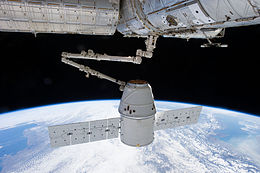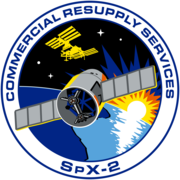SpaceX CRS-2

The Dragon spacecraft being berthed to Harmony on March 3, 2013
|
|
| Mission type | ISS resupply |
|---|---|
| Operator | SpaceX/NASA |
| COSPAR ID | 2013-010A |
| SATCAT no. | 39115 |
| Mission duration | 25 days |
| Spacecraft properties | |
| Spacecraft type | Dragon |
| Manufacturer | SpaceX |
| Start of mission | |
| Launch date | March 1, 2013, 15:10 UTC |
| Rocket | Falcon 9 v1.0 |
| Launch site | Cape Canaveral SLC-40 |
| Contractor | SpaceX |
| End of mission | |
| Disposal | Recovered |
| Landing date | March 26, 2013, 16:34 UTC |
| Orbital parameters | |
| Reference system | Geocentric |
| Regime | Low Earth |
| Perigee | 212 km (132 mi) |
| Apogee | 326 km (203 mi) |
| Inclination | 51.66 degrees |
| Period | 89.76 minutes |
| Epoch | March 1, 2013, 16:55:51 UTC |
| Berthing at ISS | |
| Berthing port | Harmony nadir |
| RMS capture | March 3, 2013, 10:31 UTC |
| Berthing date | March 3, 2013, 13:56 UTC |
| Unberthing date | March 26, 2013, 08:10 UTC |
| RMS release | March 26, 2013, 10:56 UTC |
| Time berthed | 22 days, 18 hours, 14 minutes |
| Cargo | |
| Mass | 677 kg (1,493 lb) |
| Pressurised | 677 kg (1,493 lb) |
|
|
|
SpaceX CRS-2, also known as SpX-2, was the fourth flight for SpaceX's uncrewed Dragon cargo spacecraft, the fifth and final flight for the company's two-stage Falcon 9 v1.0 launch vehicle, and the second SpaceX operational mission contracted to NASA under a Commercial Resupply Services contract.
The launch occurred on March 1, 2013. A minor technical issue on the Dragon spacecraft involving the RCS thruster pods occurred upon reaching orbit, but it was recoverable. The vehicle was released from the station on March 26, 2013, at 10:56 UTC and splashed down in the Pacific Ocean at 16:34 UTC.
The planned shipment of the Falcon 9 first stage from Texas to the Florida launch site was delayed due to the ongoing investigation of the engine failure that occurred on the previous flight. In late November 2012, it was reported that the CRS-2 Falcon 9 had been transported to Cape Canaveral. A static fire test occurred for the CRS-2 Falcon 9 on February 25, 2013.
The Dragon unpressurized trunk section, which allows the transport of unpressurized cargo to the ISS, had its first use on this flight. This cargo consisted of two Heat Rejection Subsystem Grapple Fixtures (HRSGFs), which are essentially bars to be attached to the ISS radiators to allow for future movement work.
When launched the CRS-2 Dragon was filled with about 1,493 lb (677 kg) of cargo, 1,268 lb (575 kg) without packaging. Included is 178 lb (81 kg) of crew supplies, 766 lb (347 kg) of scientific experiments and experiment hardware, 298 lb (135 kg) of hardware for the station and other miscellaneous items, among them a CD copy of the song "Up in the Air" by rock band Thirty Seconds to Mars, was premiered on board the International Space Station on March 18, 2013, during a NASA TV broadcast from the station. The two Heat Rejection Subsystem Grapple Fixtures (HRSGFs) had a combined weight of 487 lb (221 kg) and were transported to the ISS inside the unpressurized Dragon trunk as external cargo.
...
Wikipedia

